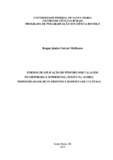| dc.creator | Bellinaso, Roque Junior Sartori | |
| dc.date.accessioned | 2021-08-19T23:48:37Z | |
| dc.date.available | 2021-08-19T23:48:37Z | |
| dc.date.issued | 2019-03-08 | |
| dc.identifier.uri | http://repositorio.ufsm.br/handle/1/22010 | |
| dc.description.abstract | Soybean (Glycine max) is grown in a large part of Brazil's arable land, predominantly under no-tillage system (SPD), where the application of fertilizers and limestone to the soil surface has increased. This management and fertilization and correction of the soil acidity can lead to a reduction of the productive potential of the soybean. The objective of this work was to evaluate the productive behavior and the root system of the soybean when cultivated under different modes of application of phosphorus (P) and limestone, as well as to evaluate the alteration of soil chemical attributes caused by the treatments. In this work the application of P incorporated to the soil in the sowing line on the surface and without P under the condition of surface liming and incorporated into the soil was carried out. The following parameters were evaluated: soybean yield, oat and wheat dry matter, nutrient concentration (N, Ca, Mg, P) in the soybean tissue, distribution and length of the root system, and changes in chemical attributes (P, K , Ca, Mg, pH, potential acidity) in the soil profile. The incorporation of limestone provided better soil acidity correction in subsurface, as well as a better distribution of Ca and Mg in the soil profile, providing higher soybean yield. The application of P incorporated into the soil and in the sowing line, with limestone incorporation, provided the highest yield of soybean, as well as higher levels of P and Mg in the soybean tissue. There was a stimulus to root growth of soybean in soil regions with higher P content. P and limestone contribute positively to soybean growth, especially when located in regions close to the root.
Key word | eng |
| dc.description.sponsorship | Conselho Nacional de Pesquisa e Desenvolvimento Científico e Tecnológico - CNPq | por |
| dc.description.sponsorship | Coordenação de Aperfeiçoamento de Pessoal de Nível Superior - CAPES | por |
| dc.language | por | por |
| dc.publisher | Universidade Federal de Santa Maria | por |
| dc.rights | Attribution-NonCommercial-NoDerivatives 4.0 International | * |
| dc.rights.uri | http://creativecommons.org/licenses/by-nc-nd/4.0/ | * |
| dc.subject | Glycine max | eng |
| dc.subject | Acidez do solo | por |
| dc.subject | Modo de aplicação de fósforo | por |
| dc.title | Formas de aplicação de fósforo sob calagem incorporada e superficial: efeito na acidez, disponibilidade de nutrientes e resposta de culturas | por |
| dc.title.alternative | Forms of application of phosphorus under incorporated and surface calender: effect on acidity, nutrient availability and culture response | eng |
| dc.type | Dissertação | por |
| dc.description.resumo | A soja (Glycine max) é cultivada em grande parte das terras agricultáveis do Brasil, predominantemente sob o sistema de plantio direto (SPD), onde a prática de aplicação de fertilizantes e calcário na superfície do solo tem aumentado. Este manejo e adubação e correção da acidez do solo pode levar redução do potencial produtivo da soja. O objetivo deste trabalho foi avaliar o comportamento produtivo e o sistema radicular da soja quando cultivada sob diferentes modos de aplicação de fósforo (P) e calcário, bem como avaliar a alteração dos atributos químicos do solo causados pelos tratamentos. Neste trabalho realizou-se a aplicação de P incorporado ao solo, na linha de semeadura, em superfície e sem P, sob a condição de calagem superficial e incorporada ao solo. Foram avaliados: produtividade da soja, Massa Seca de aveia e trigo, concentração de nutrientes (N, Ca, Mg, P) no tecido da soja, distribuição e comprimento do sistema radicular, e a alteração dos atributos químicos (teor de P, K, Ca, Mg, pH, acidez potencial) no perfil do solo. A incorporação de calcário proporcionou melhores resultados de correção da acidez do solo em subsuperfície, bem como melhor distribuição de Ca e Mg no perfil do solo, proporcionando maior produtividade da soja. A aplicação de P incorporada ao solo e na linha de semeadura, com incorporação de calcário, proporcionou a maior produtividade da soja, bem como maiores teores de P e Mg no tecido da soja. Houve estímulo ao crescimento radicular da soja nas regiões do solo com maior teor de P. O P e o calcário contribuem positivamente para o crescimento da soja, especialmente quando localizados em regiões próximas à raiz. | por |
| dc.contributor.advisor1 | Santos, Danilo Rheinheimer dos | |
| dc.contributor.advisor1Lattes | http://lattes.cnpq.br/9785041985123251 | por |
| dc.contributor.referee1 | Tiecher, Tales | |
| dc.contributor.referee2 | Moro, Letícia | |
| dc.creator.Lattes | http://lattes.cnpq.br/0252255290441533 | por |
| dc.publisher.country | Brasil | por |
| dc.publisher.department | Agronomia | por |
| dc.publisher.initials | UFSM | por |
| dc.publisher.program | Programa de Pós-Graduação em Ciência do Solo | por |
| dc.subject.cnpq | CNPQ::CIENCIAS AGRARIAS::AGRONOMIA::CIENCIA DO SOLO | por |
| dc.publisher.unidade | Centro de Ciências Rurais | por |



